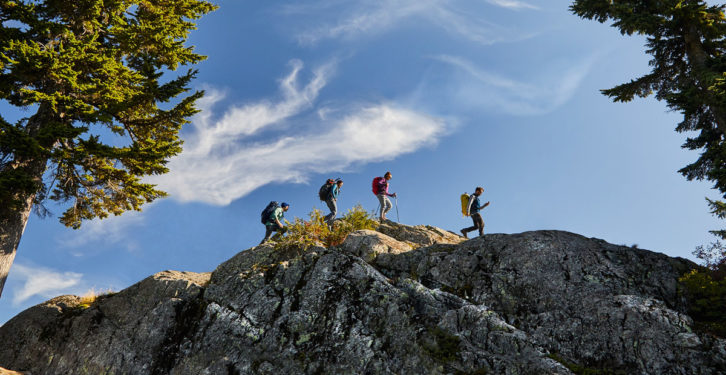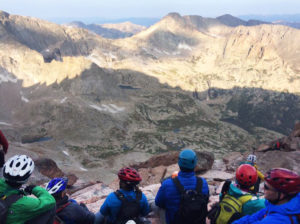
Tips for Preventing Altitude Sickness
When Chip Noble, senior product manager at Garmin, shared that he was planning to ascend Longs Peak in Colorado during a recent inReach® Field Experience webinar, he received a message from an inReach device user with helpful tips for preventing altitude sickness. Each year we hear from many inReach subscribers who had medical emergencies after ascending to higher altitudes. Given the importance of this topic, we thought it would be helpful to share these tips here.
This guidance was provided by Dr. Jim States, a recently retired physician in Washington state now specializing in community emergency preparedness who developed these tips from his experience living at base camps at 17,000’ to 18,000’ and climbing to extreme high altitude. His climbing expeditions include Denali (also known as Mount McKinley), the mountains in western Canada and the United States, and the Andes and the Himalayas, which included summiting Everest in 1983.
The objective of the tips from Dr. States is to maintain the comfort zone you experience at rest, at home and at low altitude to the top of the mountain.
These tips assume you live at a lower altitude and need to adapt to an elevation typical for North America (about 14,000’) for your expedition. An acclimatization schedule for a remote peak and a higher altitude would differ and should be customized for the mountain, approach route, and climber’s skills and experience.
Prior to and during your climb:
- Avoid alcoholic beverages while flying and traveling to base camp
- Try to spend at least one night at the trail head (two nights would be ideal)
- Stay hydrated – drink lots of liquids, even before reaching base camp
- Prepare well for where you will get water on the trail and have the gear necessary to collect water and make it safe to drink
- Consider adding electrolyte solution (such as a sports drink) to some of your container to replace electrolyte losses
- If you are not hungry while climbing, you are probably not adequately hydrated
Some current medical literature states that pushing fluids doesn’t prevent high altitude illness; however, respiration, as well as dry, cold air, is increased at altitude, which leads to fluid loss. In my experience, positive fluid balance (i.e., staying hydrated) contributes to health and performance at altitude. Dehydration at altitude increases the risks of blood clots (thrombophlebitis) that can migrate to our lungs (pulmonary embolus).
Pace and breathing:
- Start slowly during the first hour, and maintain a pace that you can sustain for 24 hours (if needed in an emergency) to reduce your early glycogen burn rate.
- Resist the competitive drive. It gets folks into trouble later in the day at altitude.
- Consciously work on breathing in time with pace and develop a rhythm of steps and breath. At higher altitude (for example, around 27,000’) your breathing ratio will change to 2-4 breaths for one step.
My experience suggests that you may increase the probability of experiencing acute mountain sickness (AMS) if you push your pace to where you can hear and feel your heart rate pounding in your head. This is probably due to increased blood flow associated with increased hypoxia.
The Sherpas taught us about pressure breathing – breathing out hard against pursed lips and making a whistling sound. It takes practice to make this kind of breathing effective and natural. Though some medical literature indicates that there is no evidence that it’s helpful, I think it helps me.
Maintenance:
Dr. States advises to stay in your bubble — so to speak — and maintain your comfort zone. Try to not get:
- Hungry
- Thirsty
- Cold
- Wet
- Tired
- Hot
Each of the above symptoms is a sign of failing body management, usually costing extra calories, fluids and energy.

Precautions:
Athletes with outstanding low-altitude endurance (such as marathon runners) are in some ways more vulnerable to altitude sickness because they are used to a cardiovascular-related perceived level of exertion. These athletes know how hard to push by how hard they are breathing and their heart rate, but they have difficulty detecting the early signs of brain edema (CE) that limits one’s rate of ascent.
CE may present as profound lethargy and fatigue with no other initial symptoms. If someone is injured at altitude and has a delayed descent, they may be at more risk of developing altitude problems. Furthermore, if someone develops increasing symptoms of AMS or CE, they need to descend as soon as possible (not the next morning) at least 3,000’ from where they developed symptoms.
Please consult with your personal physician if you have questions or concerns about your own ability to adapt to high altitude during an adventure. Some individuals have pre-existing medical conditions limiting their tolerance to high altitude, and they should seek a medical opinion from their physician before proceeding to high altitude. Serious health complications have been reported at altitudes of 8,000’ and above.
Some rapid-ascent, high-altitude troops use a prescription medication to prevent or provide early treatment for altitude sickness in conjunction with moving to a lower altitude. Again, if you are considering medication or are experiencing adverse symptoms at a higher elevation, please consult a physician.




